 In our blog How sustainable is UK consumer spending? we considered concerns of some commentators that consumer spending was growing unduly quickly given the absence of any sustained growth in disposable income. The Second Estimate of GDP, Q2 2013 reports that the economy grew by 0.7 per cent in the second quarter of the year, with household expenditure growing by 0.4 per cent.
In our blog How sustainable is UK consumer spending? we considered concerns of some commentators that consumer spending was growing unduly quickly given the absence of any sustained growth in disposable income. The Second Estimate of GDP, Q2 2013 reports that the economy grew by 0.7 per cent in the second quarter of the year, with household expenditure growing by 0.4 per cent.
Because household spending makes up about two-thirds of aggregate demand in the UK it is important to keep an eye on it. The latest figures show that the real value of consumer spending by British households has risen in each quarter since 2011 Q4. In other words, the volume of household purchases has risen for seven consecutive quarters. Over the period, the growth in real consumer spending has averaged 0.4 per cent per quarter.
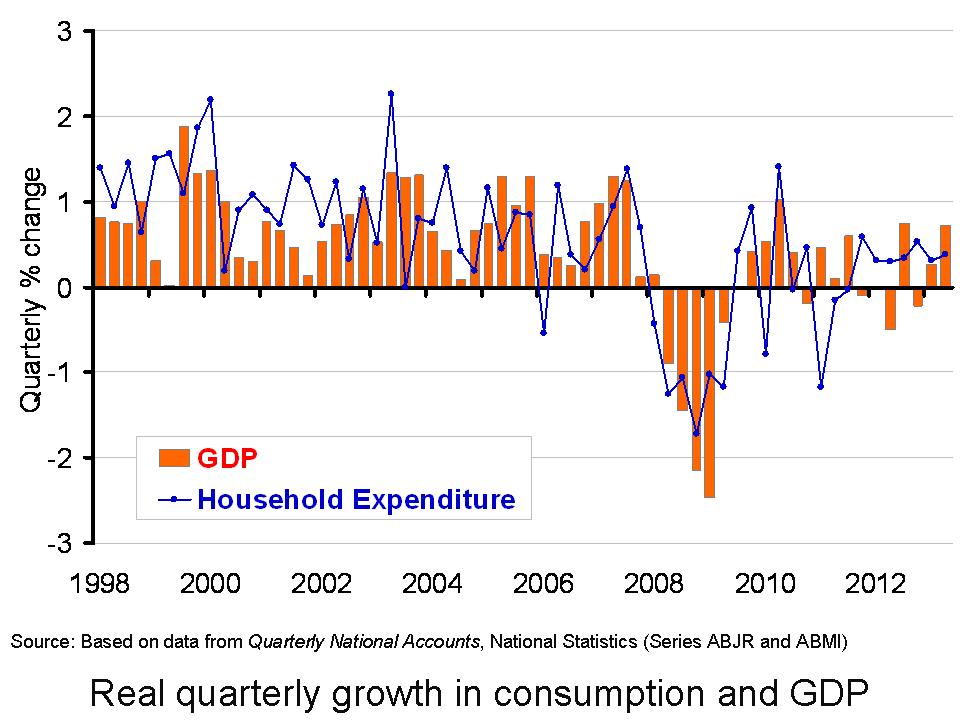 The chart helps to demonstrate the stark turnaround in the growth in consumer spending. Over the period from 2008 Q1 to 2011 Q3, real consumer spending typically fell by 0.4 per cent each quarter. As we noted in our previous blog, this was a period when the global financial system was in distress, with the availability of credit severely dampened, but also a period when households were concerned about their own financial balances and the future prospects for growth. Over the same period, real GDP typically fell by a little under 0.3 per cent each quarter. (Click here to download a PowerPoint of the chart.)
The chart helps to demonstrate the stark turnaround in the growth in consumer spending. Over the period from 2008 Q1 to 2011 Q3, real consumer spending typically fell by 0.4 per cent each quarter. As we noted in our previous blog, this was a period when the global financial system was in distress, with the availability of credit severely dampened, but also a period when households were concerned about their own financial balances and the future prospects for growth. Over the same period, real GDP typically fell by a little under 0.3 per cent each quarter. (Click here to download a PowerPoint of the chart.)
The real value of consumer spending has yet to return to its 2007 Q4 peak (£242 billion at 2010 prices). In 2013 Q2 the real value of consumer spending is estimated still to be 3 per cent below this level (£235 billion at 2010 prices). These figures are mirrored by the economy at large. Real GDP peaked in 2008 Q1 (£393 billion at 2010 prices). Despite the back-to-back quarterly increases in real GDP of 0.3 per cent in Q1 and 0.7 per cent in Q2, output in 2013 Q2 (£380 billion at 2010 prices) remains 3.2 per cent below the 2008 Q1 peak.
While real consumption values are below their 2007 Q4 peak, the concern is whether current rates of growth in consumer spending are sustainable. In particular, should this growth cause the household sector financial distress there would be real pain for the economy further down the line. Some commentators argue that the latest GDP figures are consistent with a more balanced recovery. In Q2 economic growth was supported too by other parts of the economy. For instance, we saw a 3.6 per cent rise in export volumes and a 1.7 per cent rise in gross fixed capital formation (i.e. investment expenditure).
Nonetheless, it is the protracted period over which consumer spending has been growing robustly that concerns some economists. Hence, we will need to continue to monitor the growth in all components of aggregate demand and, in particular, changes in household consumption, income, saving and borrowing.
Data
Second Estimate of GDP, Q2 2013 Dataset Office for National Statistics
Articles
New articles
UK economic growth revised up to 0.7% BBC News, (23/8/13)
UK GDP revised up to 0.7pc in second quarter: reaction Telegraph, (23/8/13)
UK rallying faster than thought as exports leap boosts GDP Independent, Russell Lynch and Ben Chu (24/8/13)
UK economy expanding faster than first thought, GDP revision shows Guardian, Heather Stewart (23/8/13)
Growth upgrade points to ‘sustainable’ recovery Telegraph, Philip Aldrick (23/8/13)
Previous articles
UK wages decline among worst in Europe BBC News, (11/8/13)
Squeezing the hourglass The Economist, (10/8/13)
UK first-quarter growth unchanged BBC News, (28/5/13)
Summer heatwave triggers shopping spree in ‘Wongaland’ economy Telegraph, Steve Hawkes and Steven Swinford (15/8/13)
Retail sales data better than expected as UK economy enjoys summer bounce Guardian, Heather Stewart (15/8/13)
Mark Carney is banking on you to keep spending Telegraph, Philip Aldrick (10/8/13)
NIESR upgrades UK economy but warns on consumer spending Telegraph, Philip Aldrick (2/8/13)
Consumers ‘expect better economy’ Belfast Telegraph, (4/8/13)
Questions
- Explain what you understand by a ‘sustainable’ economic recovery.
- What are the expenditure components that make up Aggregate Demand?
- Explain what you understand by consumption smoothing.
- Why would we would typically expect consumption growth to be less variable than that in disposable income?
- Would we expect consumption growth to always be less variable than that in disposable income? Explain your answer.
- What impact do you think the financial crisis has had on consumer behaviour?
- To what extent do you think the current growth in consumer spending is sustainable?
- How important are expectations in determining consumer behaviour?
 Household spending makes up about two-thirds of aggregate demand in the UK. Understanding its determinants is therefore important to understanding short-term economic growth. The real value of consumer spending by British households has risen in each quarter since 2011 Q4. Over the same period real disposable income has flat-lined. This suggests that the British household sector has stepped up attempts to smooth their longer-term spending profile despite the current absence of growth in their real incomes.
Household spending makes up about two-thirds of aggregate demand in the UK. Understanding its determinants is therefore important to understanding short-term economic growth. The real value of consumer spending by British households has risen in each quarter since 2011 Q4. Over the same period real disposable income has flat-lined. This suggests that the British household sector has stepped up attempts to smooth their longer-term spending profile despite the current absence of growth in their real incomes.
When viewed over many years, disposable income and consumer spending grow at very similar rates. After stripping out inflation we find that over the past 50 years both have grown at about 2½ per cent per annum. However, if we measure growth from one quarter of the year to the next we tend to find that consumption growth is less variable than disposable income. This is known as consumption smoothing.
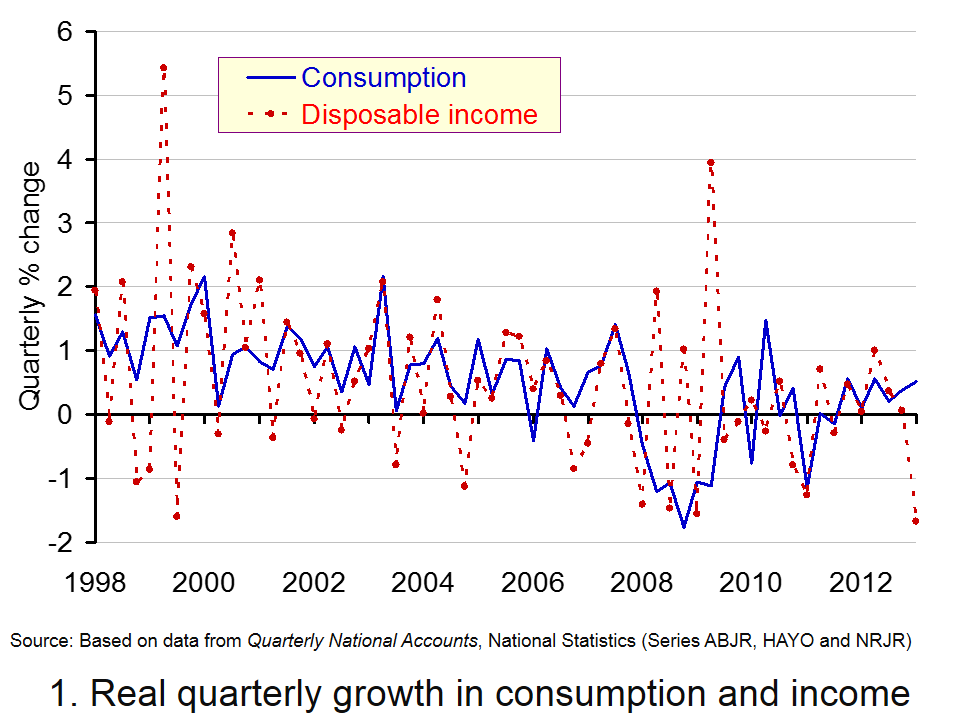 Chart 1 shows the quarterly percentage change in consumption and disposable income since 1998. (Click here to download a PowerPoint of the chart).The variability in the disposable income series is generally greater than that in consumption so helping to illustrate consumption smoothing.
Chart 1 shows the quarterly percentage change in consumption and disposable income since 1998. (Click here to download a PowerPoint of the chart).The variability in the disposable income series is generally greater than that in consumption so helping to illustrate consumption smoothing.
Consumption smoothing is facilitated by the financial system enabling us to either borrow to supplement our spending or to save to enjoy more spending in the future. The financial system can help households to avoid large variations in their spending over short periods.
Consumption smoothing does not prohibit falls in consumption nor periods when it is more variable than income. Over the period from 2008 Q1 to 2011 Q3, real consumption typically fell by 0.4 per cent each quarter while disposable income was flat. This was a period when the global financial system was in distress. Sharp contractions in credit meant that the financial system was no longer able to support economic activity as it had previously. Furthermore, households too looked to repair their balance sheets with economic uncertainty acting as an incentive to do so.
What is interesting is the extent to which British households are spending again. Since 2011 Q4 the real value of spending has typically expanded by 0.4 per cent each quarter while income growth remains largely absent. One might argue that this just demonstrates a willingness for households to engage in consumption smoothing. With credit conditions still tight, the growth in spending has been aided by a decline in the saving ratio. 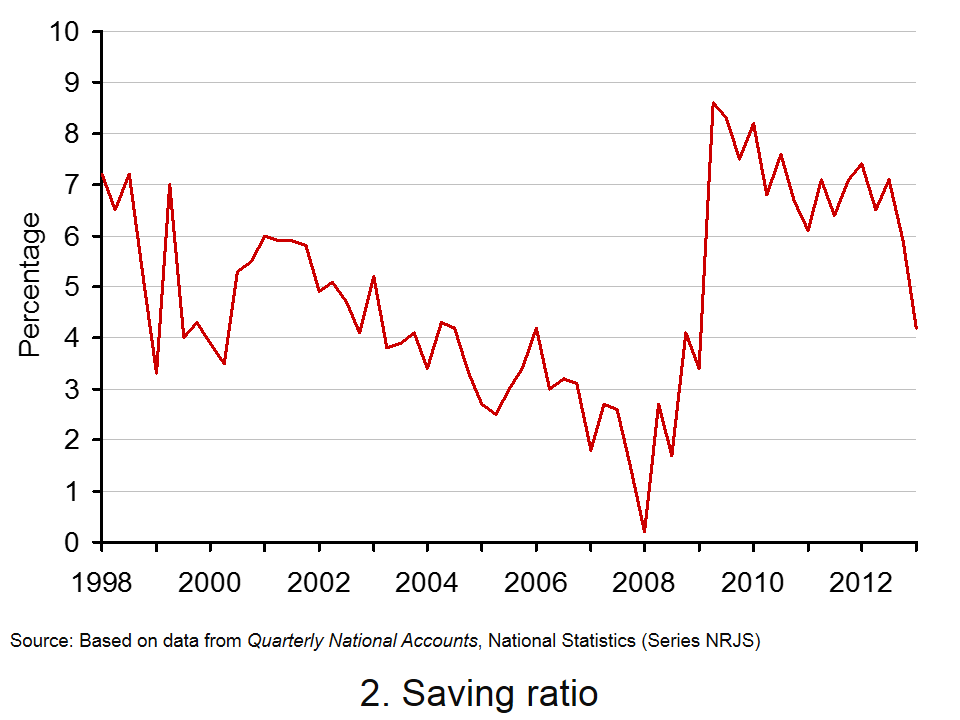 This can be seen from Chart 2.
This can be seen from Chart 2.
In 2009 Q2 the proportion of income saved hit 8.6 per cent having been as low as 0.2 per cent in 2008 Q1. In 2013 Q1 the saving ratio had fallen back to 4.2 per cent. (Click here to download a PowerPoint of the chart.)
It is of course all too easy to over-interpret data. Nonetheless, there be will concern if households look to maintain consumption growth at rates substantially greater than those in disposable income for too long a period of time. Consumption smoothing could become a real problem for future economic activity if it was to result in a financially distressed household sector. Hence, an important question is the extent to which current rates of consumption growth are sustainable. Future consumption and income trends will therefore be analysed with enormous interest.
Data
Quarterly National Accounts, Q1 2013 Dataset Office for National Statistics
Articles
UK wages decline among worst in Europe BBC News, (11/8/13)
Squeezing the hourglass The Economist, (10/8/13)
UK first-quarter growth unchanged BBC News, (28/5/13)
Summer heatwave triggers shopping spree in ‘Wongaland’ economy Telegraph, Steve Hawkes and Steven Swinford (15/8/13)
Retail sales data better than expected as UK economy enjoys summer bounce Guardian, Heather Stewart (15/8/13)
Mark Carney is banking on you to keep spending Telegraph, Philip Aldrick (10/8/13)
NIESR upgrades UK economy but warns on consumer spending Telegraph, Philip Aldrick (2/8/13)
Consumers ‘expect better economy’ Belfast Telegraph, (4/8/13)
Questions
- Explain what you understand by consumption smoothing.
- Why would we would typically expect consumption growth to be less variable than that in disposable income?
- Would we expect consumption growth to always be less variable than that in disposable income? Explain your answer.
- What impact do you think the financial crisis has had on consumer behaviour?
- To what extent do you think the current growth in consumer spending is sustainable?
- How important are expectations in determining consumer behaviour?
 When you are next in town shopping, just keep in mind that consumer spending accounts for a little over 60 per cent of GDP. Therefore, consumption is incredibly important to the economy. How consumers behave is crucial to our short-term economic growth. The second estimate of British growth from the Office for National Statistics shows that the economy expanded by 0.3 per cent in the first three months of 2013. This follows a 0.3 per cent decline in the final quarter of 2012. Real household expenditure rose by just 0.1 per cent in Q1 2013. However, this was the sixth consecutive quarter in which the volume of purchases by households has grown.
When you are next in town shopping, just keep in mind that consumer spending accounts for a little over 60 per cent of GDP. Therefore, consumption is incredibly important to the economy. How consumers behave is crucial to our short-term economic growth. The second estimate of British growth from the Office for National Statistics shows that the economy expanded by 0.3 per cent in the first three months of 2013. This follows a 0.3 per cent decline in the final quarter of 2012. Real household expenditure rose by just 0.1 per cent in Q1 2013. However, this was the sixth consecutive quarter in which the volume of purchases by households has grown.
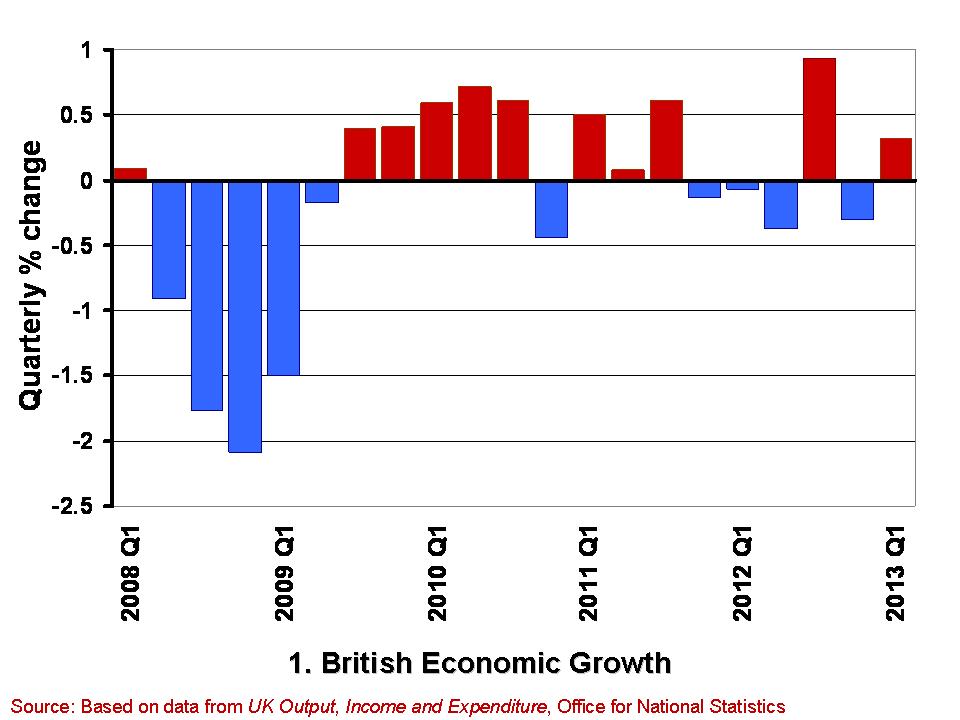 The growth in the economy is measured by changes in real GDP. Chart 1 shows the quarter-to-quarter change in real GDP since Q1 2008. (Click here to download a PowerPoint of the chart). During this period the economy is thought to have contracted in 10 of the 21 quarters shown. Furthermore, they show a double-dip recession and so two periods in close proximity where output shrank for two or more quarters. While more recent output numbers are frequently revised, which could see the double-dip recession possibly ‘statistically wiped’ from history, the period since 2008 will always been one characterised by anemic growth. The average quarterly growth rate since Q1 2008 has been -0.12 per cent.
The growth in the economy is measured by changes in real GDP. Chart 1 shows the quarter-to-quarter change in real GDP since Q1 2008. (Click here to download a PowerPoint of the chart). During this period the economy is thought to have contracted in 10 of the 21 quarters shown. Furthermore, they show a double-dip recession and so two periods in close proximity where output shrank for two or more quarters. While more recent output numbers are frequently revised, which could see the double-dip recession possibly ‘statistically wiped’ from history, the period since 2008 will always been one characterised by anemic growth. The average quarterly growth rate since Q1 2008 has been -0.12 per cent.
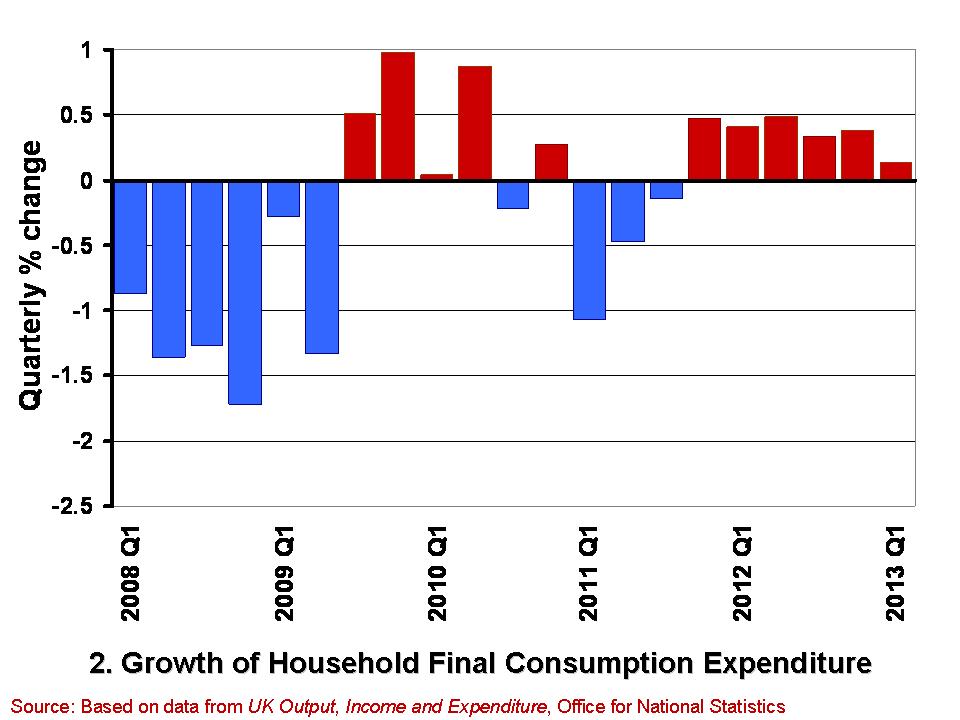 Chart 2 shows from Q1 2008 the quarterly growth in household expenditure in real terms, i.e. after stripping the effect of consumer price inflation. (Click here for a PowerPoint of the chart). Over the period, the volume of household consumption has typically fallen by 0.18 per cent per quarter. Hence, consumption has feared a little worse than the economy has a whole.
Chart 2 shows from Q1 2008 the quarterly growth in household expenditure in real terms, i.e. after stripping the effect of consumer price inflation. (Click here for a PowerPoint of the chart). Over the period, the volume of household consumption has typically fallen by 0.18 per cent per quarter. Hence, consumption has feared a little worse than the economy has a whole.
While the annualised rate of growth for the economy since Q1 2008 has averaged -0.47 per cent that for consumer spending has averaged -0.73 per cent. However, these figures disguise a recent improvement in consumer spending growth. This is because the volume of consumption has in fact grown in each of the six quarters since Q4 2011. In contrast, the economy has grown in only 2 of these quarters. It is, of course, much too early to start trumpeting consumption growth has heralding better times, not least because the 0.1 per cent growth in Q1 2013 is the weakest number since positive consumption growth resumed at the back end of 2011. Nonetheless, the figures do deserve some analysis by economists to understand what is going on.
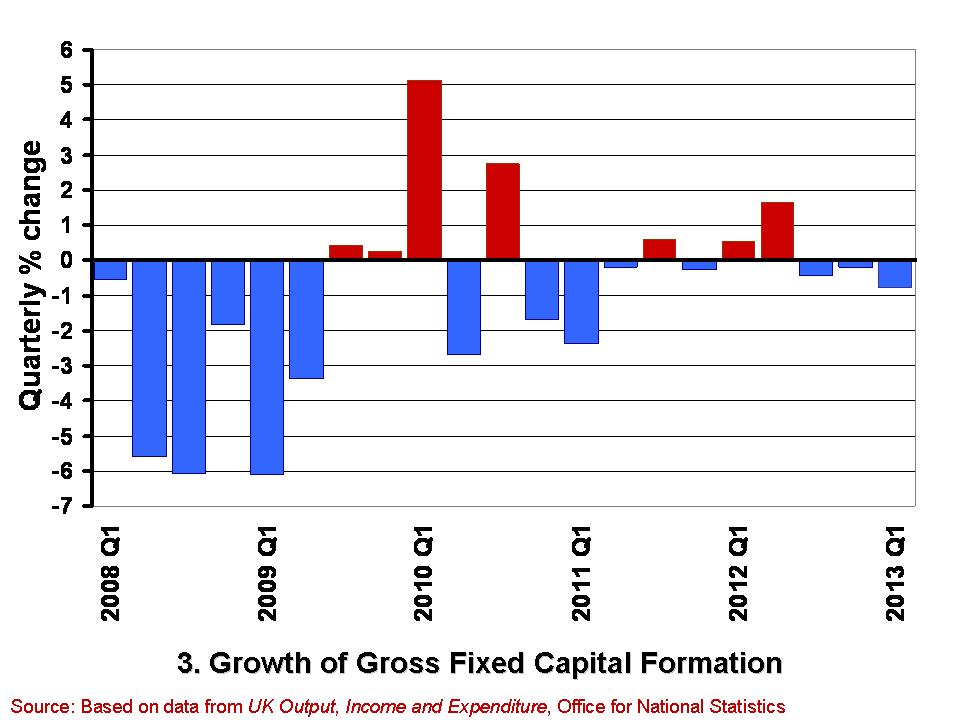 A slightly less promising note is struck by the gross fixed capital formation (GFCF) numbers. These numbers relate to the volume of investment in non-financial fixed assets, such as machinery, buildings, office space and fixtures and fittings. Chart 3 shows the quarterly growth in the volume of GFCF since Q1 2008. (Click here for a PowerPoint of the chart). The average quarterly rate of growth over this period has been -0.77 per cent. This is equivalent to an annual rate of decline of 3.9 per cent. GFCF has risen in only 7 of these quarters, declining in the remaining 14 quarters.
A slightly less promising note is struck by the gross fixed capital formation (GFCF) numbers. These numbers relate to the volume of investment in non-financial fixed assets, such as machinery, buildings, office space and fixtures and fittings. Chart 3 shows the quarterly growth in the volume of GFCF since Q1 2008. (Click here for a PowerPoint of the chart). The average quarterly rate of growth over this period has been -0.77 per cent. This is equivalent to an annual rate of decline of 3.9 per cent. GFCF has risen in only 7 of these quarters, declining in the remaining 14 quarters.
Worryingly, gross fixed capital formation has decreased in each of the last three quarters. While these figures may reflect continuing difficulties encountered by businesses in obtaining finance, they may also point to lingering concerns within the business community about the prospects for sustained growth. Therefore, it is important for economists to try and understand the drivers of these disappointing investment numbers and, hence, whether it is these or the slightly better consumption numbers that best hint at our short-term economic prospects.
Data
Second estimate of GDP, Q1 2013 Office for National Statistics
Second Estimate of GDP, Q1 2013 Dataset Office for National Statistics
Articles
UK GDP: concerns about underlying economy as 0.3pc growth confirmed Telegraph, Philip Aldrick (23/5/13)
UK investment fall among worst in G8 Guardian, Phillip Inman (23/5/13)
UK first-quarter growth unchanged BBC News (28/5/13)
U.K. Economy Grows 0.3% on Inventories, Consumer Spending Bloomberg, Svenja O’Donnell (23/5/13)
Surge in consumer spending kept UK out of recession The Telegraph (28/5/13)
Boost in service sector activity The Herald, Greig Cameron (28/5/13)
Hopes dashed as household spending rises by just 0.1% The Herald, Ian McConnell (24/5/13)
Questions
- Why do we typically focus on real GDP rather than nominal GDP when analysing economic growth?
- What is meant by aggregate demand? Of what importance is consumer spending to aggregate demand?
- Why might the patterns we observe in consumer spending differ from those in other components of aggregate demand?
- What factors might influence the determination of consumer spending?
- What do you understand by gross fixed capital formation? What factors might help to explain how its level is determined?
- Of what significance is gross fixed capital formation for aggregate demand and for aggregate supply?
- What is a recession? What is a double-dip recession?
- What data would you need to collect to identify a recession?
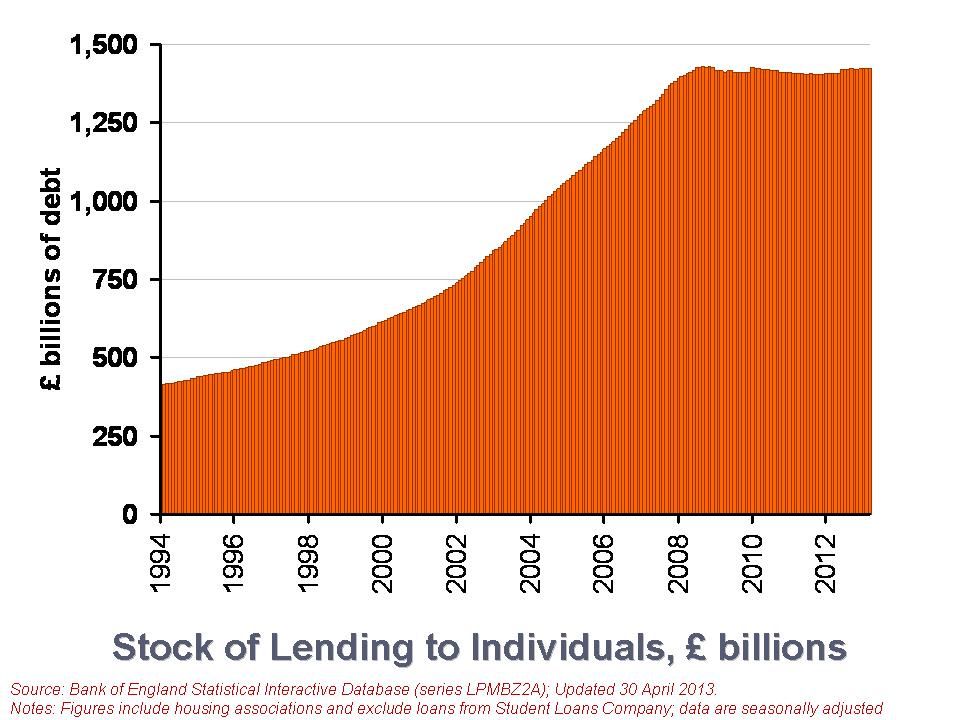 Have you ever woken in the night worrying about your finances? Most of us have. Our overall financial position undoubtedly exerts influence on our spending. Therefore, we would not expect our current spending levels to be entirely determined by our current income level.
Have you ever woken in the night worrying about your finances? Most of us have. Our overall financial position undoubtedly exerts influence on our spending. Therefore, we would not expect our current spending levels to be entirely determined by our current income level.
Our financial health, or what economists call our net financial wealth, can be calculated as the difference between our financial assets (savings) and our financial liabilities (debt). Between them, British households have amassed a stock of debt of £1.423 trillion, almost as much as annual GDP, which is around £1.5 trillion (click here to download the PowerPoint.) We look here at recent trends in loans by financial institutions to British households. We consider the effect that the financial crisis and the appetite of individuals for lending is having on the debt numbers.
There are two types of lending to individuals. The first is secured debt and refers to loans against property. In other words, secured debt is just another name for mortgage debt. The second type of lending is referred to as unsecured debt. This covers all other forms of loans involving financial institutions, including overdrafts, outstanding credit card debt and personal loans. The latest figures from the Bank of England’s Money and Credit show that as of 31 March 2013, the stock of debt owed by individuals in the UK (excluding loans involving the Student Loans Company) was £1.423 trillion. Of this, £1.265 trillion was secured debt while the remaining £157.593 billion was unsecured debt. From this, we can the significance of secured debt. It comprises 89 per cent of the stock of outstanding debt to individuals. The remaining 11 per cent is unsecured debt.
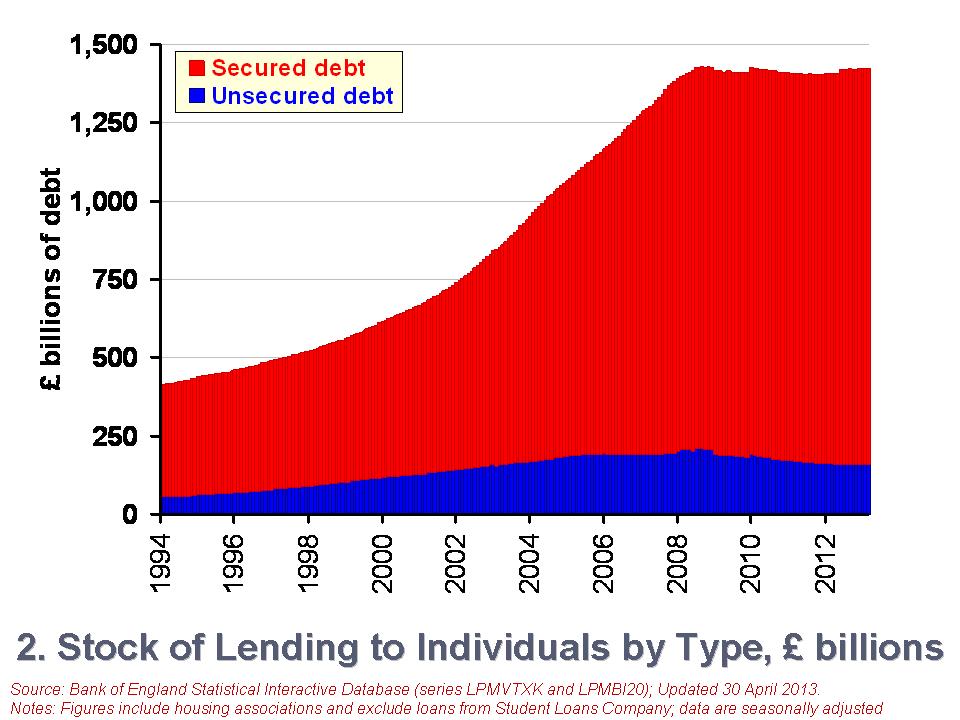 The second chart shows the growth in the stock of debt owed by individuals (click here to download the PowerPoint chart). In January 1994 the stock of secured debt stood at £358.75 billion and the stock of unsecured debt at £53.774 billion. 87 per cent of debt then was secured debt and, hence, little different to today. The total stock of debt has grown by 246 per cent between January 1994 and March 2013. Unsecured debt has grown by 197 per cent while secured debt has grown by 253 per cent.
The second chart shows the growth in the stock of debt owed by individuals (click here to download the PowerPoint chart). In January 1994 the stock of secured debt stood at £358.75 billion and the stock of unsecured debt at £53.774 billion. 87 per cent of debt then was secured debt and, hence, little different to today. The total stock of debt has grown by 246 per cent between January 1994 and March 2013. Unsecured debt has grown by 197 per cent while secured debt has grown by 253 per cent.
However, more recently we see a different picture evolving, more especially in unsecured debt. Since October 2008, the monthly series of the stock of unsecured debt has fallen on 47 occasions and risen on only 7 occasions. In contrast, the stock of secured debt has fallen on only 12 occasions and often by very small amounts. Consequently, the stock of unsecured debt has fallen by 23.2 per cent between October 2008 and March 2013. In contrast, the stock of secured debt has risen by 3.5 per cent. The total stock of debt has fallen by 0.4 per cent over this period.
Another way of looking at changes in the stock of debt is to focus on what are known as net lending figures. This is simply the difference between the gross amount lent in a period and the amount repaid. The net lending figures will, of course, mirror changes in the total debt stock closely. For example, a negative net lending figure means that repayments are greater than gross lending. This will translate into a fall in the stock of debt. However, some difference occurs when debts have to be written off and not repaid.
 The third chart shows net lending figures since January 1994 (click here to download the PowerPoint chart). The chart captures the financial crisis very nicely. We can readily see a collapse of net lending by financial institutions to households. It is, of course, difficult to disentangle from the net lending figures those changes driven by changes in the supply of credit by financial institutions and those from changes in the demand for credit by individuals. But, we can be certain that the enormous change in credit levels in 2008 were driven by a massive reduction in the provision of credit.
The third chart shows net lending figures since January 1994 (click here to download the PowerPoint chart). The chart captures the financial crisis very nicely. We can readily see a collapse of net lending by financial institutions to households. It is, of course, difficult to disentangle from the net lending figures those changes driven by changes in the supply of credit by financial institutions and those from changes in the demand for credit by individuals. But, we can be certain that the enormous change in credit levels in 2008 were driven by a massive reduction in the provision of credit.
To further put the net lending figures into context, consider the following numbers. Over the period from January 2000 to December 2007, the average amount of monthly net lending was £8.52 billion. In contrast, since January 2009 the average amount of net lending has been £691 million per month. Consider too the composition of this net lending. The average amount of net secured lending between January 2000 and December 2007 was £7.13 billion per month compared with £1.39 billion for net unsecured lending. Since January 2009, monthly net secured lending has averaged only £756 million while monthly net unsecured lending has averaged -£64.4 million. Therefore, repayments of unsecured lending have outstripped gross unsecured lending.
While further analysis is needed to fully understand the drivers of the net lending figures, it is, nonetheless, clear that the financial system of 2013 is very different to that prior to the financial crisis. This change is affecting the growth of the debt stock of households. This is most obviously the case with unsecured debt. The stock of unsecured debt in March 2013 is 24 per cent smaller than in its peak in September 2008. It is now the job of economists to understand the implications of how the new emerging patterns in household debt will affect our behaviour and overall economic activity.
Data
Money and Credit – March 2013 Bank of England
Statistical Interactive Database Bank of England
Articles
Bank of England extends lending scheme Financial Times, Chris Giles (24/4/13)
Markets insight: Europe and the US lines cross on household debt ratio Financial Times, Gillian Tett (9/5/13)
British families are the deepest in debt Telegraph, James Kirkup (14/5/13)
Total property debt of British households stands as £848bn Guardian, Hilary Osborne (13/5/13)
Household finances reach best level in three years – but are stuck below pre-crisis levels This is Money.co.uk, Matt West (17/5/13)
ONS says Welsh households have lowest debts in Britain BBC News (28/1/13)
Questions
- Outline the ways in which the financial system could impact on the spending behaviour of households.
- Why might the current level of income not always be the main determinant of a household’s spending?
- How might uncertainty affect spending and saving by households?
- Explain what you understand by net lending to individuals. How does net lending to individuals affect stocks of debt?
- Outline the main patterns seen in the stock of household debt over the past decade and discuss what you consider to be the principal reasons for these patterns.
- If you were updating this blog in a year’s time, how different would you expect the charts to look?
 Events on the high street continue to grab the headlines. These are incredibly difficult times for retailers as households’ spending power continues to be squeezed and, in conjunction with technological change, households’ spending habits continue to evolve. In this blog we examine what the latest data from Consumer Trends tells us about the composition of household spending.
Events on the high street continue to grab the headlines. These are incredibly difficult times for retailers as households’ spending power continues to be squeezed and, in conjunction with technological change, households’ spending habits continue to evolve. In this blog we examine what the latest data from Consumer Trends tells us about the composition of household spending.
There are 12 broad categories of household spending. Each tells us something about the amount of expenditure in the UK by both UK and foreign households. In 2012 Q3, the value of household consumption taking place within the UK was £242 billion. During the whole of 2011, spending amounted to £929 billion. In real terms (after adjusting for price changes) spending in the UK fell by 1 per cent in 2011. Evidence of a rebound is limited. In the year to 2012 Q3, the volume of spending was just 0.8 per cent higher. In contrast, from 1998 to 2007 the average real rate of growth was 3.5 per cent.
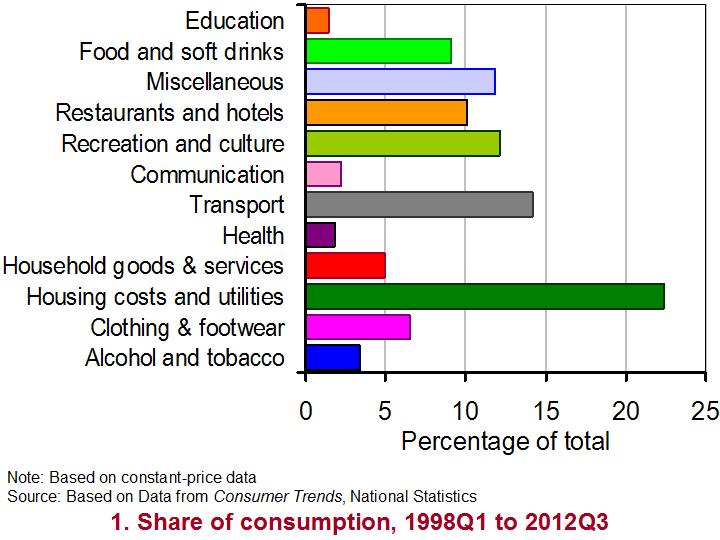 As Chart 1 shows, the largest component of household spending in the UK is on spending associated with running a home. This component includes rents, expenditures incurred in undertaking routine maintenance and the payments for electricity, gas and water. Since 1997 this component has typically accounted for (after adjusting for price changes) 24 per cent of household consumption in the UK (22 per cent in 2012 Q3). The second largest consumption category is transport. This includes expenditure on purchasing vehicles, fuels, maintenance of vehicles and the costs of rail and air transport. It has typically accounted for about 15 per cent of expenditure (14 per cent in 2012 Q3).
As Chart 1 shows, the largest component of household spending in the UK is on spending associated with running a home. This component includes rents, expenditures incurred in undertaking routine maintenance and the payments for electricity, gas and water. Since 1997 this component has typically accounted for (after adjusting for price changes) 24 per cent of household consumption in the UK (22 per cent in 2012 Q3). The second largest consumption category is transport. This includes expenditure on purchasing vehicles, fuels, maintenance of vehicles and the costs of rail and air transport. It has typically accounted for about 15 per cent of expenditure (14 per cent in 2012 Q3).
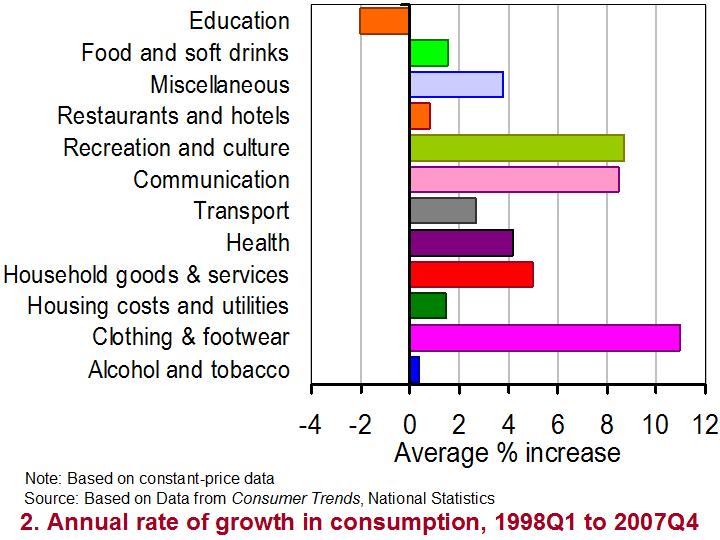 Chart 2 shows the real annual rate of growth in expenditure of our 12 consumption categories from 1998 Q1 to 2007 Q4 and so before the financial crisis really took hold. It enables us to measure how the volume of purchases changes over a 12-month period. From it, we can see that all categories, except education, contributed to the positive real growth of household spending in the UK. The fastest growing component was clothing and footwear recording real growth of almost 11 per cent per year. The second most rapidly growing component was recreation and culture, which includes items ranging from package holidays, garden plants and musical instruments to sports equipment, cameras and books. This component grew, after adjusting for inflation, by nearly 9 per cent per year.
Chart 2 shows the real annual rate of growth in expenditure of our 12 consumption categories from 1998 Q1 to 2007 Q4 and so before the financial crisis really took hold. It enables us to measure how the volume of purchases changes over a 12-month period. From it, we can see that all categories, except education, contributed to the positive real growth of household spending in the UK. The fastest growing component was clothing and footwear recording real growth of almost 11 per cent per year. The second most rapidly growing component was recreation and culture, which includes items ranging from package holidays, garden plants and musical instruments to sports equipment, cameras and books. This component grew, after adjusting for inflation, by nearly 9 per cent per year.
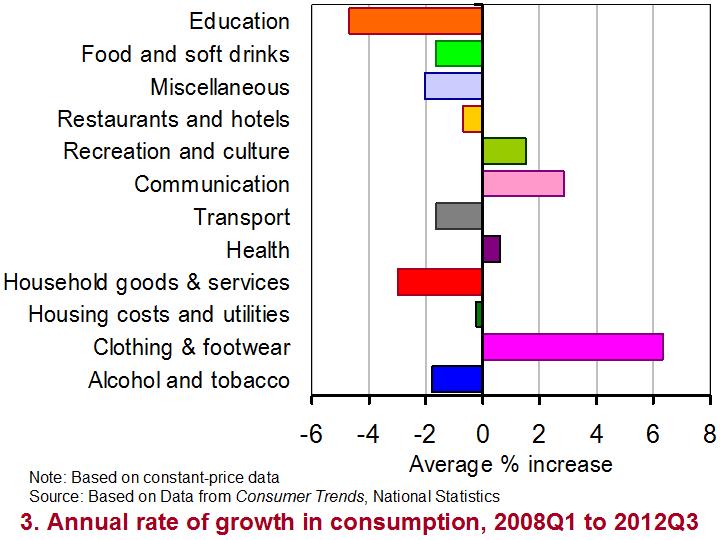 Chart 3 focuses on the real annual rate of growth since 2008 Q1. It paints a very different picture. Now only four categories have on average recorded positive annual rates of growth. Again, the volume of purchases of clothing and footwear has grown most rapidly by 6.3 per cent per year. While purchases on items associated with recreation and culture continue to grow, the annual rate of growth since 2008 is only 1.5 per cent compared with 9 per cent prior in the previous 10 years or so.
Chart 3 focuses on the real annual rate of growth since 2008 Q1. It paints a very different picture. Now only four categories have on average recorded positive annual rates of growth. Again, the volume of purchases of clothing and footwear has grown most rapidly by 6.3 per cent per year. While purchases on items associated with recreation and culture continue to grow, the annual rate of growth since 2008 is only 1.5 per cent compared with 9 per cent prior in the previous 10 years or so.
(Click here for a PowerPoint of all three charts.)
One category of spending that has been especially badly affected by events since 2008 has been household goods and services. This includes items such as furniture, major and small household appliances (including electrical appliances), carpets and tools. While the volume of purchases grew by 5 per cent per year from 1998 to 2007, since 2008 they have typically contracted at a rate of 3 per cent per year. This category helps to illustrate the difficult trading environment currently faced by many businesses in the UK.
Data
Consumer Trends, Q3 2012 Statistical Bulletin National Statistics
Consumer Trends Time Series Dataset, Q3 2012 National Statistics
Articles
Surprise UK retail sales drop fuels trip-dip recession fears The Guardian, Larry Elliott (15/2/13)
UK retail sales fall unexpectedly in January BBC News, (15/2/13)
Retail sales: What the economists say The Guardian, Phillip Inman (15/2/13)
Another dark day for the high street as John Lewis cuts jobs The Guardian, Sarah Butler (13/2/13)
Republic chains enters administration BBC News, (15/2/13)
High Street retailers: Who has been hit the hardest? BBC News, (13/2/13)
Questions
- Using Charts 2 and Chart 3 construct a short briefing paper comparing the fortunes of difficult components of consumption before and after 2008.
- What economic factors could explain the contrasting impact of the economic slowdown since 2008 on the components of consumption?
- Can economic factors alone explain the success of failure of businesses? Explain your answer drawing on real-world examples.
- What factors do you think are likely to be important for the growth in consumer spending in the months ahead?
 In our blog How sustainable is UK consumer spending? we considered concerns of some commentators that consumer spending was growing unduly quickly given the absence of any sustained growth in disposable income. The Second Estimate of GDP, Q2 2013 reports that the economy grew by 0.7 per cent in the second quarter of the year, with household expenditure growing by 0.4 per cent.
In our blog How sustainable is UK consumer spending? we considered concerns of some commentators that consumer spending was growing unduly quickly given the absence of any sustained growth in disposable income. The Second Estimate of GDP, Q2 2013 reports that the economy grew by 0.7 per cent in the second quarter of the year, with household expenditure growing by 0.4 per cent.  The chart helps to demonstrate the stark turnaround in the growth in consumer spending. Over the period from 2008 Q1 to 2011 Q3, real consumer spending typically fell by 0.4 per cent each quarter. As we noted in our previous blog, this was a period when the global financial system was in distress, with the availability of credit severely dampened, but also a period when households were concerned about their own financial balances and the future prospects for growth. Over the same period, real GDP typically fell by a little under 0.3 per cent each quarter. (Click here to download a PowerPoint of the chart.)
The chart helps to demonstrate the stark turnaround in the growth in consumer spending. Over the period from 2008 Q1 to 2011 Q3, real consumer spending typically fell by 0.4 per cent each quarter. As we noted in our previous blog, this was a period when the global financial system was in distress, with the availability of credit severely dampened, but also a period when households were concerned about their own financial balances and the future prospects for growth. Over the same period, real GDP typically fell by a little under 0.3 per cent each quarter. (Click here to download a PowerPoint of the chart.)











